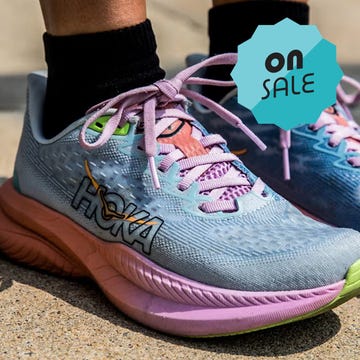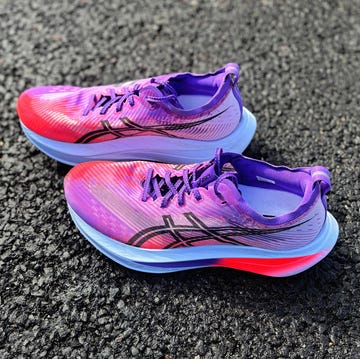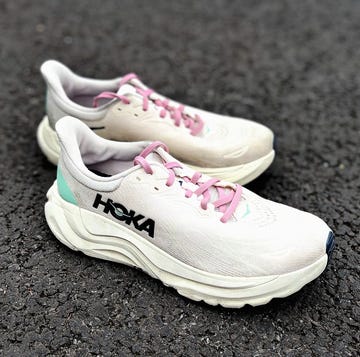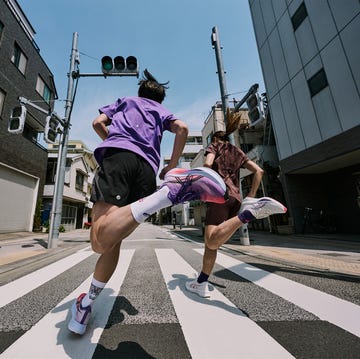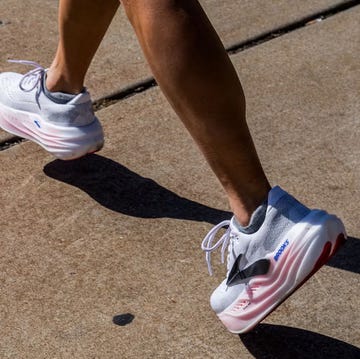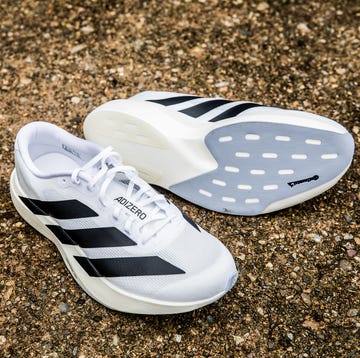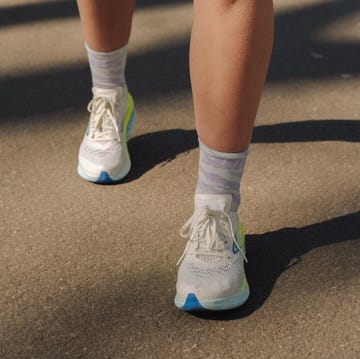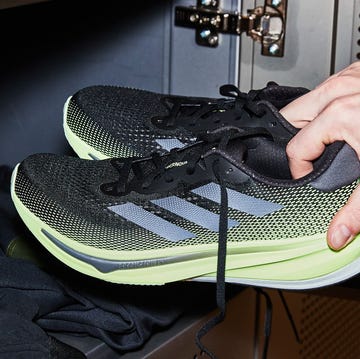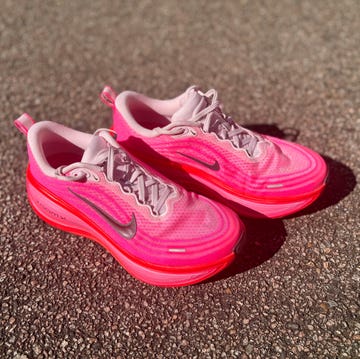- Weight: 225g (M), 180g (W)
- Stack height: 35mm (heel), 29mm (forefoot)
- Drop: 6mm
- Type: Neutral, training
The shoe
Much like the brand’s top-end SuperComp Elite racer, the New Balance Rebel has come a long way over the past few years. Launched in 2019, the original Rebel was made for the ‘everyday runner who wants to go fast’. It was a lightweight shoe that paired an early version of FuelCell foam in the forefoot with a lighter weight, firmer foam for a snappy and fairly responsive ride. It quickly gained a reputation as a go-to shoe for up-tempo sessions and even race day.
The Rebel v2 built on that success, delivering a more refined and exciting ride. Though lacking durability, it became a cult favourite among faster runners looking for a plated feel without the plate.
Then came the Rebel v3 — a shoe that marked a shift in philosophy. In an effort to create a ‘more universal underfoot ride and upper fit’, New Balance softened the shoe further to broaden its appeal. This democratisation divided opinion: some welcomed the added comfort and versatility, while others missed the raw propulsion of the v2.
What everyone's reading
Last year, though, it felt like the Rebel was back on form. In the v4, New Balance introduced a PEBA/EVA blended midsole that offered fun and versatility across virtually every speed, while keeping things lightweight and refreshingly lower-stack. In fact, it was one of the best running shoes we tried last year.
It wasn’t totally flawless, though. The FantomFit upper wasn’t as foot-hugging as the v3, while the tongue felt like an afterthought. And that brings us onto the new kid on the block: the Rebel v5.
So, what’s changed? First up, there’s an additional 5mm of foam packed into the midsole, bringing the stack height up from 30mm/24mm (heel/forefoot) to 35mm/29mm. There’s also more padding around the collar and on the new tongue (hoorah!), plus additional rubber on the outsole. The result isn’t a completely overhaul – like the SC Elite v5 versus the SC Elite v4 – but it’s not a minor update, either. Things are just...different.
Still, the price remains unchanged – £140 — and for a shoe with PEBA in its midsole, this is excellent value.
Design and fit
You’ll see two colourways of the Rebel v5 floating around at present: the urgent red, which is available in limited quantities as an early release, and the white/deep purple/brown, which will be available from July 1 2025. I received the former, which is a little ‘Dennis the Menace’ core. But I like it. I have to call out the primary colourway, though — New Balance have really nailed the lifestyle-aesthetic here: the kind of thing you’d happily wear for a post-run coffee or pint.
The Rebel v5 uses the same FantomFit upper as the v4 – a heat-bonded, mesh film. The fit isn’t one I’d describe as ‘foot-wrapping’ on either shoe. In fact, while v5 is definitely more fitted, it’s still a little loose in the forefoot area – unusual for a more tempo-leaning shoe. Still, I don’t find it obstructive to the actual running experience and there’s plenty of breathability.
I talked about the changes to New Balance’s sizing in my review of the SC Elite v5. In short: its women’s shoes no longer go beyond a UK size 8. I’m an 8.5 in most running shoes, so New Balance sent me the Rebel v5 in a UK 9/EU 43. Presuming I’ve received a men’s sample, which would be built on a different last to the women’s shoe, this could be why I find the shoe a little loose at the back of the toe box. Length-wise, though, I have just the right amount of room.
The tongue is a huge improvement, though – it actually feels like New Balance have thought about it this time around, instead of replicating the strange frayed-edged, felt-like tongue of the v4. It strikes a good balance between being padded but not overbuilt. It’s the same story for the heel collar: there’s more padding than the v4, which should cause less issues in that department. I’ve logged over 100km on my pair so far and haven’t experienced any hotspots or discomfort.
New Balance Rebel v5: Performance
Part of the Rebel v4’s charm was how different it felt from most shoes in 2024 – flatter, snappier and more race-adjacent than the soft, high-stacked trend dominating the market. The v5 still has that Rebel DNA, but it’s...changed. With more foam underfoot, it now feels like a more classic daily trainer, albeit a lively one, rather than a firmer uptempo shoe.
That’s not necessarily a bad thing – it’s still versatile, just in a different way. While the v4 was my go-to for tempo runs and medium efforts, the v5 is something I’d pick for a long run or a progressive session. You do have to work with it a bit more than a plated shoe, but I quite like that – it makes you feel engaged with the run. The blended FuelCell midsole also feels reactive and soft underfoot, though it perhaps lacks the energy return of Adidas’ LightStrike Pro.
There are some subtle design tweaks, too: the shoe sits on a slightly wider platform than the v4, with a touch more lateral flare. This aids stability. On the other hand, the heel flares less than before – with more of a curved, beveled heel. This is important, because the Rebel has never been a shoe with a dramatic rocker, so the more rounded heel helps to roll the foot forward more smoothly, benefitting heel strikers like myself and preventing the ride from feeling clunky. In the v4, I found the shoe could ‘bottom out’ running uphill, whereas I haven’t found this to be an issue with the v5.
If I were to compare the Rebel v5 to other shoes, I’d say it shares a similar degree of versatility to the Asics Novablast 5 and Adidas Adizero Evo SL, but it sits somewhere in between the two in terms of ride. The Rebel v5 is lighter, nimbler and more reactive than the Novablast, but softer, more forgiving and less snappy than the Evo SL. Where the Rebel v4 and Evo SL might have previously been pitted against each other, the Rebel v5 leans more towards the Novablast’s end of the versatility spectrum. Again, none of this is bad – the Rebel v5 really is an excellent shoe; comfortable, controlled and capable of handling a variety of distances and paces. It’s just not directly comparable to the v4. So, if you’re in the market for a fresh pair of Rebels, just know it won’t be a like-for-like comparison. Likewise, if you’re currently using the Rebel v4 for a lot of your speedwork, you might be better off with a shoe like the Evo SL.
RW verdict
If you’re looking for versatility, the Rebel v5 is still one of the best shoes out there. It’s comfortable straight out the box, the ride feels fluid and dialled in, and it copes admirably at a variety of paces. In exchange for a shoe that can handle longer mileage, you have lost a little of the snap from the v4, but the Rebel is ultimately still a more speed-orientated training shoe than an out-and-out daily trainer like the Hoka Clifton 10 or the Saucony Ride 18 – and for £140 it’s a leader in its price bracket.








